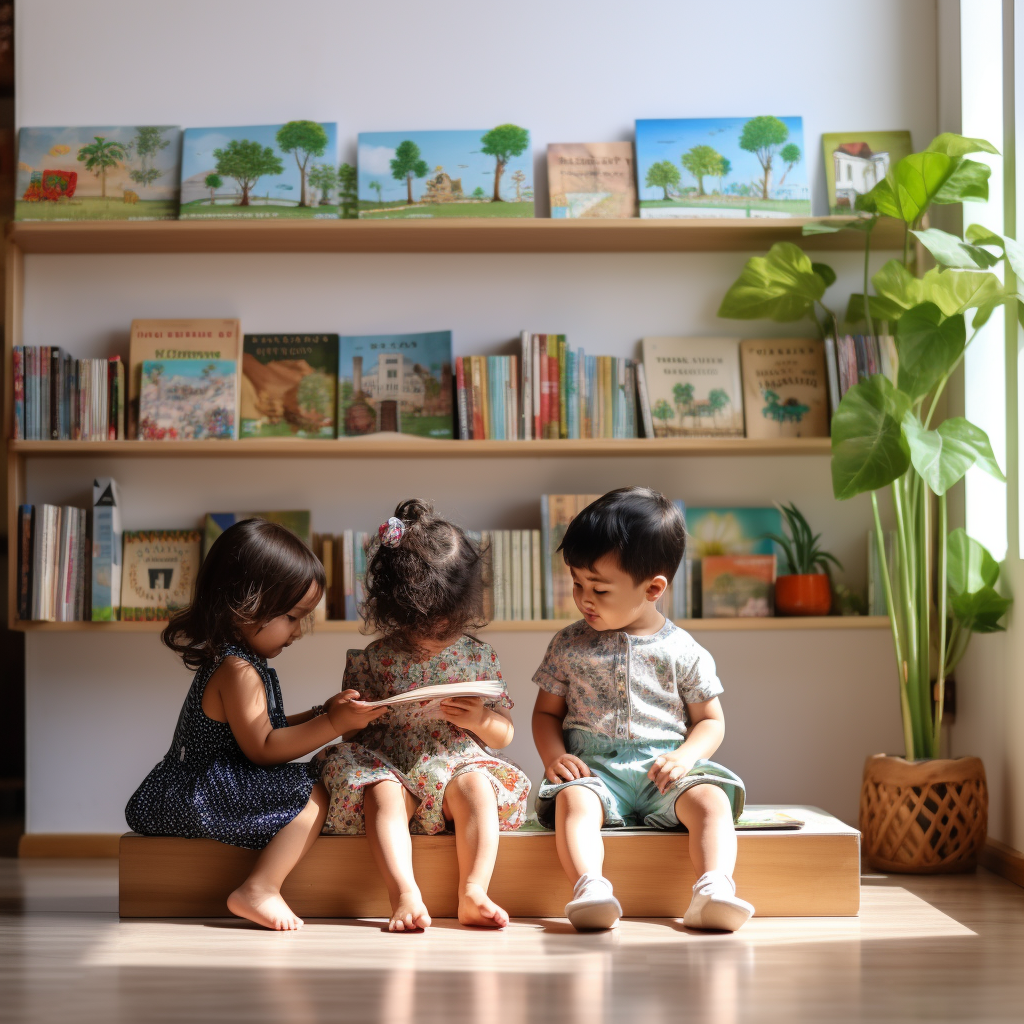“The shelves must be low and easily accessible so that the child can exercise free choice to select the objects which he prefers…Thus even the youngest child goes through the preparatory exercises of caring for himself and for the environment.”
So wrote Dr. Maria Montessori in her 1948 book,Discovery of the Child, outlining the role thoughtfully crafted environments play unveiling children’s innate potential. Among the most essential features still found in Montessori classrooms worldwide remains accessible book displays understood to exponentially impact early language, literacy and even self-actualized development.
While fanciful bookcases populate many child spaces today purely serving decorative purposes alone, Montessori principles guide intentional bookshelf curation transforming the simplest wood frames into empowering literacy launchpads when anchored by child choice, development appropriateness and caretaking opportunities.
Let’s examine bookshelves as cornerstones within Montessori educational models, how mentorship and independence intertwine uniquely across classroom collections plus strategies families at home can implement capturing the same enrichment through Montessori bookshelf wisdom inspiring young minds word by word.
Language Absorption Through Environment Exposure
A fundamental theory across Montessori education posits language acquisition occurs almost by mental osmosis for young children properly exposed to enriched spoken and written vocabularies consistently. Concrete language stimulation literally builds brains as neural networks expand meeting cognitive uptake effortslessly.
Receptive language starts percolating months before babies actively verbalize thanks to surrounding linguistic soundscapes shaping auditory processing capability. Visualspectra also prompt cognitive connections to symbolic meanings critical for reading comprehension. By immersing children in vocabulary even passively through stable displays of books, poetry pages and environmental print, adults “tap the absorbent mind” triggering unconscious lexical retention beginning remarkably early.
Unlike force feeding infants flashcards or drilling toddlers to recite, the Montessori language environment remains thoughtfully engineered to nurture organic literacy by making written beauty silently available for young minds to unconsciously marvel at through quality exposures.
Books as Coded Communication Objects
Print literacy trails oral language achievement by several years in childhood. Yet written symbols hold incredible potency gaining meaning through adults “decoding stories” as children gradually detect recurring visual patterns across pages. Montessori education begins transitioning paper sign systems like books from mystery to mastery using models, schemas and sequencing.
Children classify differing book sizes and thicknesses on shelves through active touch comparing tactile heft. Sorting sturdy board titles from delicate paperbacks allows sensory discrimination between objects. Matching fiction cover art themes together or coordinating nonfiction spines by color bands helps young minds categorize styles and genres – observational pillars proving foundational for processing printed information.
Such playful literacy games build visual acuity, sharp concentration plus conceptual organization have children master literary tools intuitively. Storytime sessions then magnify comprehension and vocabulary retention exponentially.
Equipping environments with shelves showcasing displayed stories, lovingly introduced then revisited across days, months and years generates crucial early reading schemata for successfully transitioning symbols into meaningful narrative down road.
Instilling Ownership Through Classroom Book Collections
Core to Montessori methodology remains upholding children’s dignity by conveying responsibility, independence and caretaking opportunities from the earliest years onward. Mistaking external compliance for capability severely underestimates youth potential. Montessori environments entrust young kids elevating tasks like safeguarding classroom materials and spaces to witness incredible commitment shining through.
Beside standard reading corners, teachers curate classroom libraries students self-manage. After proper display and book introduction lessons, children rotate throughout weeks selecting personalized choices then navigating re-shelving and categorization independently upon finishing. This transfers book upkeep duties fully into young hands.
Such empowerment teaches organization, sequencing, motor coordination plus impulse control as children pace browsing, handle delicate pages gently while moving between rooms and commit returning items accurately where found. Mastering such mindfulness proves no small feat for restless preschoolers yet bears monumental hidden fruits cultivating self-discipline, nurturing concentration and anchoring sturdy attention spans yielding rewards across all developmental domains.
Additionally, owning space caretaking crystallizes emotional investment literally stocking shelves with objects of inspiration and imagination kids grown to know and love. They follow meticulous routines preserving fragile pages from wear after embracing books as treasured classroom gems to protect. Few leadership opportunities compare for garnering cooperative intent.
Montessori Book Displays As Generators for Family Literacy
While school settings contain obvious infrastructure for housing expansive libraries to seed literacy systematically in children’s lives, parents need not rely solely on institutional resources to soak up Montessori benefits at home. Simply organizing several shelves for displayed books accessible to kids manifests advantages.
Curating Qualified Collections Apply discernment selecting child appropriate titles in home libraries. Balance board books for infants along with story treasuries offering rhymes, cultural fables, nature reflections and recipe adventures for toddlers on up. Ensure shelves showcase alphabet primers plus counting concept primers for earliest math introduction beside illustrated nonfiction subjects like transportation varieties, architectural wonders and animal kingdom explorations illuminating science. Display a spectrum spanning beloved picture book classics to early chapter series installation and anthology volumes where stories build in complexity. Provide international folktales introducing geography diversity. Rotate seasonal stories bringing symbolic meaning to harvest rituals, winter hibernations and spring’s great awakening. Fill shelves with whimsy and the full wealth of human wisdom honoring childhood while expanding horizons!
Promoting Imagination and Choice Allow children full access choosing displayed stories they wish to engage without limiting or requiring certain book quotas. Follow in interest inquiring after selections that capture attention over days, weeks, months planting seeds for lifelong literary affinity. Read together often but also foster independent reading rituals at intervals that exercise concentration skills.
Role model reading as pastime through parents and older siblings enjoying books alongside tiny tots. Demonstrate collecting favorite story gems to curate personal home libraries. Guide understanding towards subtle book handling and responsible page turning. Yet also permit children to linger as long they desire across one story slowly building focus and narrative comprehension simultaneously.
Equipping Independence and Care Expect and gently guide children returning books accurately upon completion. Establish consistent household system whether alphabetical organization or custom categories so students hone basic classification capability assisting collections. Assign feather-duster accessibility for routine shelf cleansing tasks. Praise diligent dusting keeping beloved books in best condition. Have children alert adults noticing damaged books for repairs. Instilling protective ownership towards home libraries elevates conscientiousness and timeliness.
Environment Shapes the Self As Books Shape the Mind
Montessori education founder Maria Montessori declared, “the secret of good teaching is to regard the child’s intelligence as a fertile field in which seeds may be sown, to grow under the heat of flaming imagination. Our aim is not only to make the child understand, and still less to force him to memorize, but so to touch his imagination as to enthuse him to his innermost core.”
What richer seed exists fostering such abundant human growth than literacy? And what brighter catalyst awakens flaming imagination than vibrant displays stocks full featuring tales transporting youth into whole new worlds ripe for exploring?
Yet beyond developing intellectual potential for consuming goodness through great reads, Montessori benefits manifest emotionally and socially from responsibility, environmental care and displayed collections kids proudly preserve gifting treasures to next generations.
While education models focus academics heavily, Montessori methodology proves the humble bookshelf scaffolds far more than literacy alone. Independence blossoms seeing small hands capable of big things like nurturing beautiful book habitats. Concentration deepens returning well loved stories in timely fashion then selecting new adventures awaiting. Visual acuity strengthens registering subtle differences between spines and cover motifs across re-shelving. And most monumentally, a lifelong identity as capable bibliophiles overflows through children organically interacting with this enlightening object called the book.
So families take inspiration from Montessori classrooms leveraging bookshelf magic at home. Clear simple storage cubes or basic pine cases offer blank canvases for curating thrilling adventures into knowledge realms uniting youth. Display but also delegate caretaking bringing children into ownership of these prized anthologies they’ll value forever more. Guide safe handling yet give freedom lifting picture tabs and turning gilded pages at their chosen pace. Demonstrate passion for reading then set children loose cultivating their own literary affinities. For across such seemingly simple shelves rests no short of a lifetime’s worth of human wonder patiently waiting to stir imagination and elevate destinies one beautiful book after another!

